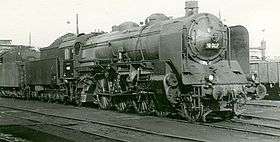Saxon XVIII H
The Saxon Class XVIII was a German six-coupled tender locomotive built for the Royal Saxon State Railways (Königlich Sächsische Staatseisenbahnen) in 1917/18 for express train services. The Deutsche Reichsbahn grouped them in 1925 into DRG Class 18.0.
| Saxon XVIII H DRG Class 18.0 | |
|---|---|
 | |
| Number(s) | 196–205 18 001–010 |
| Quantity | 10 |
| Manufacturer | Sächsische Maschinenfabrik, Chemnitz |
| Year(s) of manufacture | 1917/18 |
| Retired | 1965 |
| Wheel arrangement | 4-6-2 |
| Axle arrangement | 2'C1' h3 |
| Track gauge | 1,435 mm (4 ft 8 1⁄2 in) |
| Length | 22,150 mm (72 ft 8 in) |
| Height | 4,550 mm (14 ft 11 in) |
| Wheelbase | 4,100 mm (13 ft 5 in) |
| Overall wheelbase | 11,375 mm (37 ft 3.8 in) |
| Wheelbase incl. tender | 18,597 mm (61 ft 0.2 in) |
| Empty weight | 84.4 t |
| Service weight | 93.5 t |
| Adhesive weight | 50.7 t |
| Axle load | 16.9 t |
| Top speed | 120 km/h (75 mph) |
| Indicated Power | 1,700 PSi |
| Driving wheel diameter | 1,905 mm (6 ft 3.0 in) |
| Leading wheel diameter | 1,065 mm (3 ft 5.9 in) |
| Trailing wheel diameter | 1,260 mm (4 ft 2 in) |
| Valve gear | Walschaerts (Heusinger) |
| No. of cylinders | 3 |
| Cylinder bore | 500 mm (20 in) |
| Piston stroke | 630 mm (25 in) |
| Boiler Overpressure | 14 bar |
| No. of heating tubes | 156 |
| Grate area | 4.52 m2 (48.7 sq ft) |
| Radiative heating area | 15.6 m2 (168 sq ft) |
| Tube heating area | 200.6 m2 (2,159 sq ft) |
| Superheater area | 72.00 m2 (775.0 sq ft) |
| Evaporative heating area | 215.76 m2 (2,322.4 sq ft) |
| Tender | sä 2'2' T 31 |
| Brakes | Westinghouse compressed-air brake |
History
After a number of four-cylinder compounds had been taken into service in Saxony, the Saxon XVIII H appeared with a three-cylinder engine based on a Prussian prototype. In 1917 and 1918 the Sächsische Maschinenfabrik in Chemnitz built ten examples of this class.
The newly formed Deutsche Reichsbahn took all 10 locomotives in 1925 over and gave them the numbers 18 001–010.
Locomotive 18 002 was destroyed in the Second World War; the remaining engines went into the Deutsche Reichsbahn in East Germany after the war had ended. They were station at Dresden-Altstadt locomotive depot and were later retired between 1963 and 1965.
Design features
To begin with the Class XIII H had a boiler with a firebox located above the frame. This was made from three boiler rings, the third one being slightly conical in shape. The boiler feedwater was supplied through two steam injectors and a Knorr feedwater pump with preheater. The second injector was later omitted.
The steam engine was configured as a three-cylinder system with simple steam expansion. Two cylinders were located in the usual horizontal position on the outside, the third cylinder was built between the frame sides at an angle. All three cylinders drove the second coupled axle. The gearing of the inside cylinder was operated from the Heusinger valve gear of the outside cylinders via levers and intermediate shafts.
The three coupled axles were fixed in the frame. The leading bogie had a side play of 38 mm, the trailing Adams axle could swing 60 mm to the side.
The locomotive brake was a Westinghouse compressed-air brake. Braking worked on one side of all the carrying and coupled wheels. Some of the locomotives were later equipped with Indusi train protection.
The locomotives were coupled to Saxon sä 2'2' T 31 tenders.
Service
Because the trains on the Central Mountain routes were largely hauled by the powerful successor class, the Saxon XX HV (DRG Class 19.0), the Saxon XVIII Hs were mainly deployed on less hilly lines of Dresden–Leipzig and Dresden–Berlin. After the Second World War the nine remaining engines were concentrated in Dresden and were mostly used to haul express services to Berlin.
See also
- List of Saxon locomotives and railbuses
- Royal Saxon State Railways
Sources
- Näbrich, Fritz; Meyer, Günter; Preuß, Reiner (1983). Lokomotivarchiv Sachsen 1 (in German). Berlin: transpress VEB Verlag für Verkehrswesen.
- Preuß, Erich; Preuß, Rainer (1991). Sächsische Staatseisenbahnen (in German). Berlin: transpress Verlagsgesellschaft mbH. ISBN 3-344-70700-0.
- Reiche, Günther (1998). Richard Hartmann und seine Lokomotiven (in German). Berlin/Chemnitz: Oberbaumverlag. ISBN 3-928254-56-1.
External links
| Wikimedia Commons has media related to Saxonian XVIII H. |
- Models of DRG Class 18.0
- Die Lokomotive (in German)